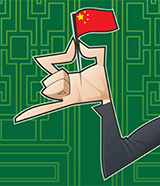 |
|
|
BELT AND ROAD |
|
It is the institution bankers most want to know.
“Silk Road Fund has raised a lot of money and is the best place for market intelligence,” says Sumit Dayal, global head of corporate finance at Standard Chartered. “No single outbound deal happens without Silk Road Fund knowing about it.”
Silk Road Fund dates from the 2014 Beijing APEC conference, when it was established by Xi Jinping with $40 billion.
“President Xi announced the decision to build a financing platform as the breakthrough for the problem of interconnection and communication,” explains Jin Qi, chair of the Silk Road Fund in Beijing. Jin is a former People’s Bank of China assistant governor who has also worked at the IMF. “Silk Road Fund is a critical measure to implement the Belt and Road Initiative.” At a summit in May this year, Xi committed a further Rmb100 billion ($15 billion).
“Since its foundation Silk Road Fund has persistently adhered to being a market-oriented, international and professional investment institution, actively seeking investment opportunity and exploring creative investment models to support the Belt and Road Initiative,” says Jin.
She says that by the end of June 2017, the fund had signed 16 contracts and committed to investing $6.8 billion, more than 70% of it through equity investments.
The fund’s investments have covered infrastructure, resources exploration, industrial cooperation and financial cooperation in nations and regions along the Belt and Road, with what Jin calls a “large-scale and multi-layered project repository” already created.
“Investment projects already implemented by the Silk Road Fund have strongly supported the match between China’s quality capacity exports and technology cooperation with the development needs of the countries it has invested in,” she says. (By “quality capacity exports”, she means that China has accumulated strong expertise and experience, as well as an advantage of production capacity in certain sectors, such as high-speed railway and building hydropower stations.)
Jin says projects so far have “encouraged the industrialization, urbanization and the ability to enhance economic sustainable development in the host countries. This plays an absolutely critical role for the mutual profit and development between China and related countries along the routes of the Belt and Road.”
‘Rigorous’
So how does it work? Does the Silk Road Fund go out into the world and decide what it wants to build? Or do countries come to it with projects? The answer, Jin says, is both: “Some projects are recommended by related governments, financial institutions and real enterprises. Others may be developed by the Silk Road Fund itself.”
She calls the fund “a commercial investment organization” and says it has “a rigorous investment procedure. The fund operates on its own, disciplined by itself, takes risks and is responsible for its own loss and profit. So if projects are propitious for promoting trade cooperation and connectivity, we will always consider them.”
 |
|
Jin Qi, Silk Road Fund |
Jin corrects Euromoney on our use of the term “recipient countries” in a question. “That concept is usually used for aiding and contributory projects, so it is inappropriate to use this phrase, since the Silk Road Fund doesn’t include any aid funding,” she says. She prefers the phrase “host countries”, putting her fund more into the context of international direct investment.
“The investments from Silk Road Fund follow commercial principles and international rules,” she says. “Therefore the dialogues between host countries and the fund are no different to those with other commercial institutions.”
Jin depicts the fund repeatedly as a commercial venture that collaborates with other funding sources.
“The Silk Road Fund has contacted and cooperated with multilateral development agencies, international and domestic financial institutions and various types of enterprises,” she says. “Cooperation is mainly on the project level. These are beneficial to us to complement with our partners, broaden investment and cooperation channels, and enrich sources of funds.”
The Silk Road Fund is a limited partner in an IFC fund focusing on emerging Asia and is also an investor in the China-France FC Value Trail Fund, which focuses on technology, healthcare and environmental protection.
Jin says the fund is interested in joint investments with “sophisticated international financial institutions”.
Asked to project how the fund will look in future, she expects that the fund will focus on growing its strengths.
“Within three to five years, the Silk Road Fund will continuously enlarge its investment scale and distribution, and keep improving its investment quality and economic return,” she says. It will develop professional investment talent, promote Belt and Road construction and development, and lay a solid foundation for “becoming an internationally leading investment organization.”



